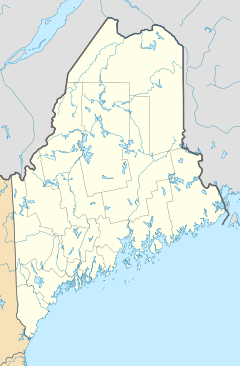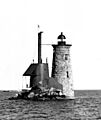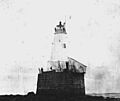Whaleback Light facts for kids
 |
|
| Whaleback Lighthouse | |
|
|
|
| Location | Piscataqua River entrance, Kittery, Maine |
|---|---|
| Coordinates | 43°3′31.534″N 70°41′46.701″W / 43.05875944°N 70.69630583°W |
| Year first constructed | 1830 |
| Year first lit | 1872 (current tower) |
| Automated | 1963 |
| Foundation | Stone / timber |
| Construction | Granite blocks |
| Tower shape | Conical |
| Markings / pattern | Natural |
| Focal height | 59 feet (18 m) |
| Original lens | Fourth order Fresnel lens, 1855 |
| Current lens | VLB-44 |
| Range | 14 nautical miles (26 km; 16 mi) |
| Characteristic | Grp Flash (2) White, 10s |
| Fog signal | HORN: 2 every 30s |
| Admiralty number | J0232 |
| ARLHS number | USA-963 |
| USCG number | 1-0200 |
The Whaleback Light is a cool old lighthouse that helps guide ships into the Piscataqua River near Kittery, Maine. It stands on some rocks out in the water, a bit away from the land. The lighthouse you see today was built in 1872. It was added to the National Register of Historic Places in 1988, which means it's an important historical site!
Contents
History of Whaleback Light
Building the First Lighthouse
The first lighthouse at this spot was built in 1830. It cost about $20,000, which was a lot of money back then! In 1855, the light got an upgrade. It received a new top part (called a lantern) and a special lens. This lens was a fourth order Fresnel lens, which made the light much brighter.
Storms and a New Tower
In 1863, a fog bell and its tower were added. This bell would ring to warn ships when it was foggy. But storms caused problems for the lighthouse. By 1869, the tower and its base had cracks. So, people decided to build a brand new, stronger tower.
The new tower was finished in 1872. It was built right next to the old one. This new tower, which is still standing, was made from strong granite blocks. These blocks were fitted together like puzzle pieces. The old tower was taken down in 1880.
How the Lighthouse Works Today
The light in the tower is about 59 feet (18 meters) above the average sea level. Inside the tower, there used to be living spaces for the lighthouse keeper. There was also a storage area.
At some point, the fog bell was replaced with a loud horn. In 1991, the horn's sound was made quieter. This was because the super loud blasts were actually hurting the lighthouse structure!
The Whaleback Light became automated in 1963. This means it no longer needed a person to live there and operate it. Machines took over the job.
Today, the lighthouse flashes white twice every 10 seconds. This light comes from a modern VLB-44 LED light. It was put in place in October 2009.
Who Owns the Lighthouse Now?
In 2007, a law called the National Historic Lighthouse Preservation Act made the Whaleback Lighthouse available for a new owner. The American Lighthouse Foundation and a group called Friends of Portsmouth Harbor Lighthouses wanted to take care of it. In November 2008, they officially became the new owners. They now help protect this important piece of history.
Lighthouse Keepers
For many years, brave people called lighthouse keepers lived and worked at Whaleback Light. They made sure the light was always shining. This helped ships stay safe. Here are some of the people who kept the light burning:
- Samuel E. Haskell (1831–1839)
- Joseph L. Locke (1839–1840)
- Jedediah Rand (1849–1853)
- Reuben T. Leavitt (1853–1859)
- Joel P. Reynolds (1861–1864)
- Gilbert Amee (1864-1869)
- James W. Verney (1869–1871)
- Ferdinand Barr (1871)
- Chandler Martin (1872–1878)
- Leander White (1878–1887)
- Ellison C. White (1887-1888)
- James M. Haley (1888–1893)
- Walter S. Amee (1893–1921)
- Arnold B. White (1921–1941)
- Morgan W. Willis (1948-1950)
- Francis D. Hickey (Coast Guard, c. 1956-1957)
- Stephen H. Rogers (USCG, c. 1957-1958)
- James Pope (Coast Guard, c. early 1960s)
Images for kids




